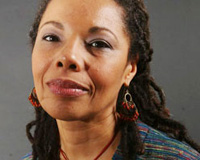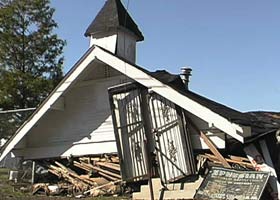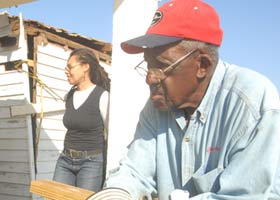
June Cross has produced for FRONTLINE since the early 1990s. Her films include Secret Daughter, The Two Nations of Black America, and Russian Roulette.
- Related Link
- NewsHour with Jim Lehrer
June Cross talks with Ray Suarez about The Old Man and the Storm.
So much had already happened by the time I first met Herbert Gettridge in Februrary 2006. He already had lost most that he owned and knew in the world; he would lose still more.
The city had just finished celebrating the first Mardi Gras after Katrina. The streets had been cleaned up, but large swaths of the city had no traffic lights. Electrical service was spotty. Finding groceries remained a challenge. In the wealthy Lake Pontchartrain area, along the city's northern border, National Guard patrolled the streets; in the Lower Ninth, residents had to circumvent blockades to get to their damaged homes.
My first post-Katrina visit had been back in December 2005, just three months after the flood. The city was a postapocalyptic vision: an entire landscape covered by grey sludge and the dank scent of decay. The bars and restaurants were filled mostly with men in white shirts and loosened ties: insurance adjusters and federal bureaucrats picking over the city's bones to determine what was worth salvaging.
The Gettridges were actually the fifth family I'd asked to participate in this documentary. Others had first agreed but then reneged when the reality of rebuilding collided with the imperative of revealing their innermost feelings on national television. It was just too raw, too painful. I arrived back at the hotel every night exhausted myself: exhausted from listening to their stories and from simply navigating a city in which maps were useless. There were no street signs. There was no bus service, no trolley.
I was reduced to feeling my way around the neighborhoods: Is this the Eighth Ward? the Ninth? I would stop to take pictures. I found a church, Ephesians Baptist, that had pancaked diagonally, its steeple askew on its slanted roof. The sight of it gave me pause: here was a whole congregation -- choirs, youth groups, deacons, sisters cooking Sunday dinners -- gone. What had happened to them?
I had an idea what had happened to them, and what could lie ahead, because I had just finished reading Root Shock by Mindy Fullilove. Fullilove is a community research psychiatrist at Columbia University's Mailman School of Public Health. Her book documents what happens when communities get dispersed -- the health consequences traumatized people suffer as their network of friends, families, and neighbors are moved around to make room for urban renewal. I suspected that something similar would happen in New Orleans as the rebuilding process began.

Even at that early stage, that process was already laden with controversy. A consulting group hired by a group of city fathers had recommended rebuilding the city, beginning with the areas easiest to salvage and then moving outwards. That meant that not only traditionally working-class neighborhoods like the Lower Ninth, but solidly middle-class areas like Gentilly and even upper-class areas like Lake Pontchartrain might lie fallow or be turned into "green space".
The residents of Lake Pontchartrain reacted by hiring an architectural consultant to come up with a design plan for their own community. In the Lower Ninth, the residents' greatest resource was their hands, and the knowledge of how to use them. They were men like Herbert Gettridge.
He seemed like Sisyphus when I met him that Ash Wednesday, shoveling out a yard of endless debris. His truck had been destroyed in the flood, and he had yet to get a new one. When his wheelbarrow was full, he would dump the debris from his yard on the public part of the street. (The city had laid down an edict that homeowners were responsible for hauling away their own debris, but city dump trucks would haul away trash if it was on a public street.)
We made 22 trips to New Orleans over two years, and each time, we checked in with Mr. Gettridge, who had attracted an army of volunteers from churches and social groups to help him rebuild. Gradually, we got in touch with about two dozen members of the family. Most were reluctant to share their pain publicly. They had no desire to be featured in a reality TV version of their lives and little faith that telling their story would make any difference.
That was a shame, because they really did represent the city. In addition to the family members featured in the film, the Gettridge clan included a grandson in the police academy and a niece in the fire department; a daughter who had been an insurance adjuster and another who worked for the federal government; and one cousin, a city worker, who snapped at Mr. Gettridge when he complained about municipal services, "We got our problems too."
That was putting it mildly. As the months wore on, it seemed that responsibility for many of the city's problems could be pinned squarely on its chief executive, Mayor Ray Nagin. Nagin, a cable executive-turned-politician, had won re-election by shrewdly playing the race card after he saw support slipping among the business community.
The mayor had eloquently called out the federal government for its failure to act during Katrina, but he seemed flummoxed by the task of organizing a coherent response in its aftermath. Time and time again he would claim that this or that money hadn't been delivered to the city. But when I would check with the multi-layered bureaucracy that governed the flow of that money, I would discover that Nagin's government hadn't filed the necessary paperwork.
To be fair, the mayor had been forced to lay off half his employees after Washington refused to guarantee the city's credit, in late September 2005. Still, it seemed that we elect mayors to get money from Washington, and this one just couldn't figure out how to get the job done.
As we got to know the family, it was Mrs. Lydia Gettridge who seemed to symbolize all that the city had been and wanted to be again. If Mr. Gettridge represented the charismatic, party-loving face of the city, she represented its spiritual heart, the glue that held it together. She treasured one retrieved item: the family Bible, water-damaged but still legible. A neighbor had found it amidst the weeds, ten blocks away.
Mrs. Gettridge told me she had been the primary caretaker of the nine children the couple raised in the house at 5027 North Roman. Her husband worked long hours as a plasterer, and after hours as a longshoreman (he was a member of both unions). Mrs. Gettridge had worked for a while in a sewing factory, but largely she had stayed home.
She couldn't have raised all those children, she said, without the help of her cousins who lived within blocks of her in the Lower Ninth Ward. Her children remember well the prescribed route they had to take to school. Any deviations would be reported back to Mama Lydia, and there would be hell to pay when they got home. The house on North Roman was the one that everyone came to during holidays. No wonder Mr. Gettridge was so determined to rebuild it: It had been the center of the neighborhood.

Herbert Gettridge could look back on his life and say that he'd done good. None of his kids had gone to jail. They all had good jobs. He had been able to support them all and buy three houses himself. The one he was clearing out when we met him in February 2006 had been where his daughter Cheryl had hoped to retire to one day. The house down the street, at 5444 North Dorgenois, had been home to his son Reynaldo, a Vietnam Vet.
All told, the Gettridges and their children owned nearly a dozen properties in the New Orleans area. Like many New Orleanians, they lived in one home and rented the others. Being a landlord is a cottage industry in the city, and the vast majority of the city's renters -- up to 47,000, by one estimate -- lived in homes owned by small landlords, ten times more than those living in public housing.
In the winter of 2007, Mr. Gettridge had let the city demolish the house where we had first met him. He knew how to fix it, but he knew he would never have the energy. The other house on North Dorgenois had washed off its piers but remained otherwise intact in the middle of the road. Mr. Gettridge and several groups of volunteers had worked painstakingly to gut it while preserving the key architectural details that had led to it being nominated for landmark status. It also had a history, having been owned by a folk artist named Sister Gertrude. Sister Gertrude's art goes for upwards of $5,000, and her recordings are for sale on iTunes.
Mr. Gettridge had been trying to save the house for months. In fact, he'd hoped that if CNN's Anderson Cooper filmed Mama Lydia's return, he'd generate enough sympathy money to get it back on its piers. He needed just $30,000, and he had half of that in hand.
The week before Thanksgiving 2008 he had gone to a city hearing to get a deferral of demolition. He went by to check on it at 7 a.m. every morning. One Wednesday morning it was there, but then that afternoon, it was gone. It turned out that the city has two bureaucracies that govern demolition, and Mr. Gettridge had gone to the wrong one. Why they granted him the deferral and thus gave him false hope -- well, that's just the way New Orleans works. Last I heard, his son Reynaldo had moved across the river to the suburb known as Algeria.
In the long run, as global warming causes increasingly strong hurricanes and the wetlands protecting Southern Louisiana erode, the region is probably doomed. But to let the working and middle classes atrophy as contractors and the well-off move to protect their holdings seems not only cruel, but un-American.
The federal government has committed $18 billion to help the city come back. The U.S. Postal Service now delivers three-quarters the amount of mail it did before Katrina -- a sign the population is returning. But growth has stagnated over the last year and most of those who are returning are moving to areas that didn't flood: Algiers, Uptown, and the neighborhoods near Tulane University. Those areas are whiter, richer, and so the population of the city as a whole has shifted. Even black median income has increased.
Those statistics beg the question: What will happen to those like Mr. Gettridge back in the Lower Ninth, those who worked a lifetime, only to see their American dream washed away?